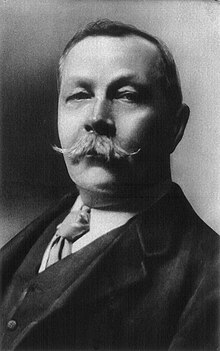About the Book: "The Adventure of the Copper Beeches", one of the 56 short Sherlock Holmes stories written by British author Sir Arthur Conan Doyle, is the last of the twelve collected in The Adventures of Sherlock Holmes. It was first published in Strand Magazine in June 1892.
About the Author: Arthur Ignatius Conan Doyle was born on 22 May 1859 at 11 Picardy Place, Edinburgh, Scotland. From 1876 to 1881, he studied medicine at the University of Edinburgh, including a period working in the town of Aston (now a district of Birmingham) and in Sheffield, as well as in Shropshire at Ruyton-XI-Towns. While studying, Doyle began writing short stories. His earliest extant fiction, "The Haunted Grange of Goresthorpe", was unsuccessfully submitted to Blackwood's Magazine. His first published piece "The Mystery of Sasassa Valley", a story set in South Africa, was printed in Chambers's Edinburgh Journal on 6 September 1879. On 20 September 1879, he published his first non-fiction article, "Gelsemium as a Poison" in the British Medical Journal. In 1882 he joined former classmate George Turnavine Budd as his partner at a medical practice in Plymouth, but their relationship proved difficult, and Doyle soon left to set up an independent practice. Arriving in Portsmouth in June of that year with less than £10 (£900 today) to his name, he set up a medical practice at 1 Bush Villas in Elm Grove, Southsea. The practice was initially not very successful. While waiting for patients, Doyle again began writing stories and composed his first novels, The Mystery of Cloomber, not published until 1888, and the unfinished Narrative of John Smith, which would go unpublished until 2011. He amassed a portfolio of short stories including "The Captain of the Pole-Star" and "J. Habakuk Jephson's Statement", both inspired by Doyle's time at sea, the latter of which popularized the mystery of the Mary Celeste and added fictional details such as the perfect condition of the ship (which had actually taken on water by the time it was discovered) and its boats remaining on board (the one boat was in fact missing) that have come to dominate popular accounts of the incident. Doyle struggled to find a publisher for his work. His first significant piece, A Study in Scarlet, was taken by Ward Lock Co. on 20 November 1886, giving Doyle £25 for all rights to the story. The piece appeared later that year in the Beeton's Christmas Annual and received good reviews in The Scotsman and the Glasgow Herald. The story featured the first appearance of Watson and Sherlock Holmes, partially modeled after his former university teacher Joseph Bell. Doyle wrote to him, "It is most certainly to you that I owe Sherlock Holmes ... Round the center of deduction and inference and observation which I have heard you inculcate I have tried to build up a man." Robert Louis Stevenson was able, even in faraway Samoa, to recognize the strong similarity between Joseph Bell and Sherlock Holmes: "My compliments on your very ingenious and very interesting adventures of Sherlock Holmes. ... Can this be my old friend Joe Bell?" Other authors sometimes suggest additional influences—for instance, the famous Edgar Allan Poe character C. Auguste Dupin. A sequel to A Study in Scarlet was commissioned and The Sign of the Four appeared in Lippincott's Magazine in February 1890, under agreement with the Ward Lock company. Doyle felt grievously exploited by Ward Lock as an author new to the publishing world and he left them. Short stories featuring Sherlock Holmes were published in the Strand Magazine. Doyle first began to write for the 'Strand' from his home at 2 Upper Wimpole Street, now marked by a memorial plaque. In this period, however, Holmes was not his sole subject and in 1893, he collaborated with J.M. Barrie on the libretto of Jane Annie. Doyle was found clutching his chest in the hall of Windlesham Manor, his house in Crowborough, East Sussex, on 7 July 1930. He died of a heart attack at the age of 71. His last words were directed toward his wife: "You are wonderful." At the time of his death, there was some controversy concerning his burial place, as he was avowedly not a Christian, considering himself a Spiritualist. He was first buried on 11 July 1930 in Windlesham rose garden. He was later reinterred together with his wife in Minstead churchyard in the New Forest, Hampshire. Carved wooden tablets to his memory and to the memory of his wife are held privately and are inaccessible to the public. That inscription reads, "Blade straight / Steel true / Arthur Conan Doyle / Born May 22nd 1859 / Passed On 7th July 1930." The epitaph on his gravestone in the churchyard reads, in part: "Steel true/Blade straight/Arthur Conan Doyle/Knight/Patriot, Physician, and man of letters". Undershaw, the home near Hindhead, Haslemere, south of London, that Doyle had built and lived in between October 1897 and September 1907, was a hotel and restaurant from 1924 until 2004. It was then bought by a developer and stood empty while conservationists and Doyle fans fought to preserve it. In 2012 the High Court ruled that the redevelopment permission be quashed because proper procedure had not been followed. A statue honours Doyle at Crowborough Cross in Crowborough, where he lived for 23 years. There is also a statue of Sherlock Holmes in Picardy Place, Edinburgh, close to the house where Doyle was born.
My Review: This is another superb short story with our main character, detective Sherlock Holmes. The plot is interesting:
Violet Hunter visits Holmes, asking whether she should accept a job as governess; a job with very strange conditions. She is enticed by the phenomenal salary which, as originally offered, is £100 a year, later increased to £120 when Miss Hunter balks at having to cut her long hair short (her previous position paid £48 a year). This is only one of many peculiar provisos to which she must agree. The employer, Jephro Rucastle, seems pleasant enough, yet Miss Hunter obviously has her suspicions.
She announces to Holmes, after the raised salary offer, that she will take the job, and Holmes suggests that if he is needed, a telegram will bring him to Hampshire, where Mr Rucastle's country estate, the Copper Beeches, is situated.
After a fortnight, Holmes receives such a message, beseeching him to come and see her in Winchester. Miss Hunter tells them one of the most singular stories that they have ever heard. Mr. Rucastle would sometimes have Miss Hunter wear a particular electric blue dress and sit in the front room reading, with her back to the front window. She began to suspect that she was not supposed to see something outside the window, and a small mirror shard hidden in her handkerchief showed her that she was right: there was a man standing there on the road looking towards the house.
At another such session, Mr Rucastle told a series of funny stories that made Miss Hunter laugh until she was quite weary. The one astonishing thing about this was that Mr. Rucastle not only did not laugh, but did not even smile.
There were other unsavoury things about the household. The six-year-old child that she was supposed to look after was astonishingly cruel to small animals. The servants, Mr. and Mrs. Toller, were quite a sour pair. A great mastiff was kept on the property, and always kept hungry. It was let out to prowl the grounds at night and Miss Hunter was warned not to cross the threshold after dark. Also, Toller, who was quite often drunk, was the only one who had any control over the dog.
There was also the odd discovery by Miss Hunter of what appeared to be her own tresses in a locked drawer. Upon checking her own luggage, however, they turned out to be another woman's, but identical in every way to Miss Hunter's, even to the unusual colour.
However, the most disturbing thing of all about the household was the mystery wing. Miss Hunter had observed that there was a part of the house that did not seem to be used. The windows were either dirty or shuttered, and once she saw Mr Rucastle coming out of the door leading into the wing looking most perturbed. Later, he explained that he used the rooms as a photographic darkroom, but Miss Hunter was not convinced.
When he is drunk, Toller leaves the keys in the door to the mystery wing. Miss Hunter sneaks in. She finds the place spooky and when she spots a shadow moving on the other side of a locked door, she panics and runs out, into Mr Rucastle's waiting arms. Mr. Rucastle does not reproach her, instead he pretends to comfort her.
However, he overdoes his act and alerts her suspicions, causing her to claim that she saw nothing. In an instant, his expression changes from comfort to rage.
With the aid of the great detective, it is discovered that someone has been kept a prisoner in the forbidden wing. The purpose of hiring Miss Hunter becomes clear: her presence is to convince the man watching from the road that Rucastle's daughter Alice, previously unknown to Miss Hunter, and whom she resembles, is no longer interested in seeing him.
Watson rescuing Rucastle from his mastiff
Holmes, Watson and Miss Hunter find Miss Rucastle's secret room empty; Rucastle arrives and thinks the trio has helped his daughter escape and goes to fetch the mastiff to set upon the trespassers. Unfortunately for Rucastle, the dog has been accidentally starved for longer than usual and attacks him instead. Watson shoots the dog with his revolver. Later, Mrs. Toller confirms Holmes' theory about Rucastle's daughter and reveals that when Alice came of age she was to receive an annuity from her late mother's will; Rucastle tried to force his daughter to sign control of the inheritance over to him which only resulted in Alice becoming ill with brain fever; hence, the cut hair. Rucastle then tried to keep Alice away from her fiancé by locking her up in the mystery wing and hiring Miss Hunter to unknowingly impersonate Alice.
Rucastle's daughter escapes with her fiancé, and they marry soon after. Watson notes, at the end of the story, that Holmes appears to have been drawn to Miss Hunter. However, to his disappointment, Holmes does not show any interest in Miss Hunter after the mystery has been solved, which was the real force behind his feelings. Rucastle survives as an invalid, kept alive solely by his second wife. Miss Hunter later becomes principal of a girls' school, where, according to Watson, she meets with "considerable success".
I recommend this short story to all readers that appreciate a well written mystery story, mainly when it involves Sherlock Holmes clever solutions!
If you read this review, feel free to leave a comment!



No comments:
Post a Comment